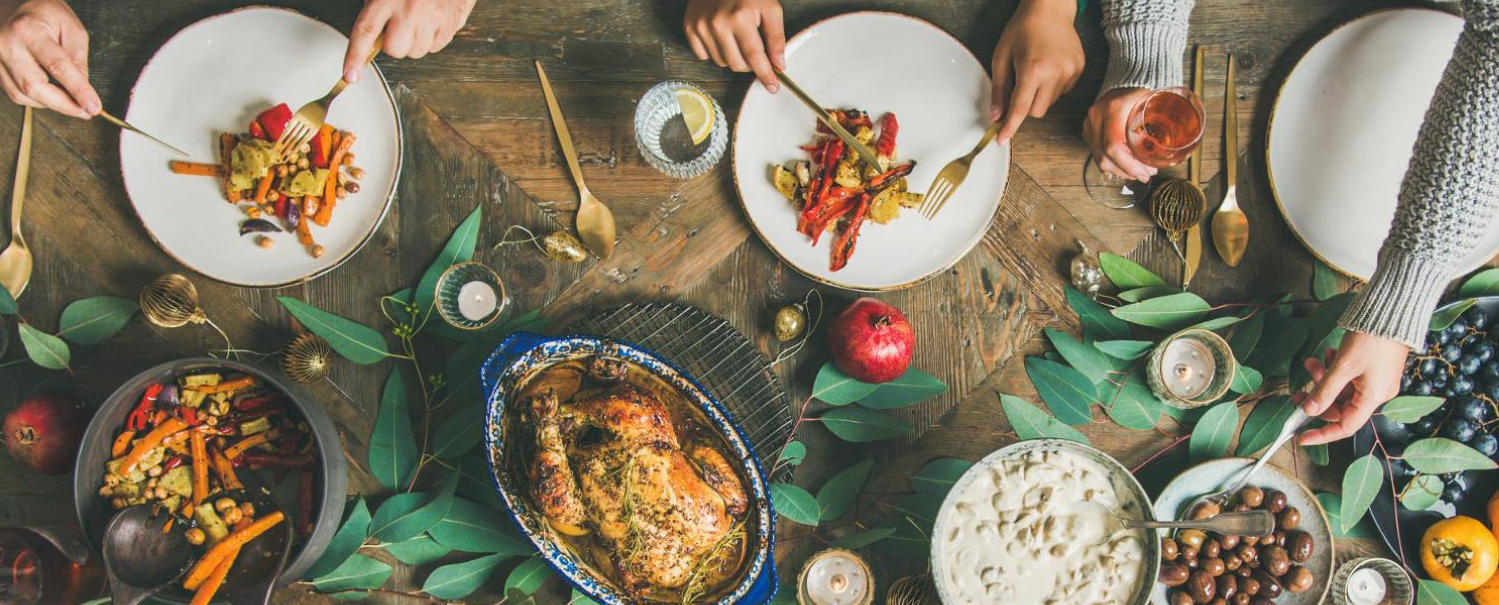The period from Thanksgiving to New Years can be a disaster for your best intentions to watch what you eat and stay active.
From rich traditional dishes to behavioral tips for overeating to hosts who don’t plan for dietary restrictions, the holidays are something of a “perfect storm” for weight gain, digestive problems, and other diet-related health issues.
“The defining characteristic of traditional holiday items like stuffing, traditional sauce and cake is that they are extremely high in calories and low in fiber,” says Susan Roberts, director of the Energy Metabolism Laboratory at the Center for Human Nutrition Research at USDA on aging. (HNRCA) at Tufts University and author of The “I” Diet. “In other words, they are the perfect combination of nutritional factors so that you eat large amounts of these foods before feeling satisfied and full.”
Holiday spreads also tend to include a variety of desserts. Refined white flour, added sugars (including “natural” sugars like honey, agave, and maple syrup), and saturated fats are the foundation of our favorite treats, but too much is also a recipe for increased risk. of diabetes, heart disease and obesity.
Even just looking at a beautiful extension amplifies the effect. “The sight and smell of abundance trigger real metabolic hunger signals and expand our stomachs so that we need to eat more to feel full,” says Roberts.
The Tufts research found that “situationally” overeating, such as during the holidays, is an important indicator of weight regain after weight loss during other times of the year, Roberts says, adding that many people seem to gain everything excess weight. during this time. Time.
The good news is, with a little planning, you can get out and join the festivities without your body paying the price.
“The best way to prevent post-holiday regret is to develop strategies ahead of time to avoid excessive consumption of unhealthy foods and beverages,” says Alice Lichtenstein, director of the HNRCA Cardiovascular Nutrition Laboratory and professor at the Friedman School of Science and Nutrition Policies. in locks. “That doesn’t mean you should deprive yourself of your holiday favorites; it just means you have to be aware of how much and how often.
Here are some ways you can take control of your holiday meals, from Lichtenstein and other Tufts nutrition experts.
Be Strategic
Be selective: You don’t have to try everything. Make an overview of everything and focus on what you absolutely love or what brings back fond memories. Use a small plate or napkin to control portion sizes.
You have a plan: Set a maximum amount you plan to eat each day and stick to it. Store your favorite items out of sight to help resist temptation. Consider delivering (contactless) some of your excess holiday gifts to family members or neighbors, especially those who can’t connect with others this year, or freezing extras.
Savor the flavors: Give yourself permission to enjoy the joys of the holiday season. Savor each (modest) bite and smile as the flavors bring back memories of past vacations and create positive thoughts for the next vacation.
Make Healthy Substitutions
Become a pescatarian. Consider centering your meal around fish, such as salmon, instead of other meats, or at least eating fish at the last minute.
Swap the sweet potatoes for regular potatoes. You will find several varieties in the supermarket, including the “yam” which is actually also a sweet potato. All are excellent sources of vitamin A, potassium, dietary fiber, and vitamin C. You’ll also get magnesium, phosphorous, choline, iron, and calcium, and only 180 calories per cup of cooked sweet potatoes.
Substitute butter and cream for the buttermilk in your white mashed potatoes and reduce your serving size. Or try baking baby potatoes, which are now available in a rainbow of colors, a sign that they’re rich in pigmentary phytonutrients.
Replace the oil with butter. Baking cakes and other baked goods with oil instead of some or all of the butter increases healthy unsaturated fats and changes the balance of saturated fats, according to Lichtenstein. It also has the added benefit of producing a moister, fluffier cake.
Reduce the amount of white flour. “Replacing at least half of the white flour with white whole wheat flour (or regular whole wheat flour) or replacing part of the white flour with almond flour is another way to improve the food quality of desserts,” Lichtenstein says. “Just keep in mind that almond and other non-wheat flours will affect the texture of your baked goods.” She adds, “Adding chopped walnuts or sunflower seeds will add an interesting texture and increase fiber, which can lead to a more moderate serving size.”
Cut that sugar. Sugar contributes to fluffiness, texture, browning, and airiness, so removing it will affect more than just sweetness. Still, leaving some of the necessary sugar out of most recipes will change them, not spoil them. If you want to eliminate sugar (or introduce sugar substitutes) in a recipe, plan to give it a try. Conventional wisdom recommends cutting back no more than a third of the sugar, but some recipes last longer. (If sugar plays a key role, such as in meringues or cakes, or even a plain yellow cake, reducing the amount isn’t really an option.)
Be a Health-Conscious Host
Ask what people can and cannot eat. If you’re hosting the meal and aren’t already familiar with your guests’ dietary needs, just ask.
Consider serving food buffet style. You can include a mix of traditional favorites and diet dishes.
Offer dishes that are easy to prepare. “Dishes with fewer ingredients make it easier for guests to know what they’re eating, and these dishes also tend to be healthier,” says Kane.
Serve the ingredients separately. “If a dish has sauce or sauce, serve it on the side so guests can decide whether or not they want to include it,” says Kane.
Keep recipes handy. If people bring dishes to share, have them write the name and recipe (or at least the ingredients) on a recipe card to place next to the dish.
Keep the product details. “Keep the packaging labels of the food you used to prepare the menu items, so guests with allergies can double-check the ingredient lists,” says Romano. Or take pictures of the packaging (including the full ingredient list) on your smartphone.
Offer some non-alcoholic but festive drinks. Many recipes for mocktails (non-alcoholic mixed drinks) can be found online. Flavored (sugar-free) sparkling water can also be festive.
Consider meal times. Let guests know what time the food will be served, especially if it’s out of the ordinary, like mid-afternoon. Guests with diabetes may need to plan ahead. Consider serving some healthy appetizers like fresh veggies with hummus dip.
Share the menu in advance. “It can help give guests an idea of what will be served so they can plan accordingly,” says Kane.
Be careful with the salt. Add minimal salt to dishes, allowing guests to add more if they wish. Opt for low-sodium or reduced-sodium ingredients when you can.
Be aware of carbs. Carbohydrate-conscious guests will appreciate the non-starchy vegetable offerings, such as a nice mixed greens salad or roasted Brussels sprouts.
Opt for vegetarian or vegan ingredients when you can. If a recipe such as stuffing, soup, or side dish calls for broth, opt for vegetable broth over chicken broth.
Make healthy side dishes that fulfill the role of a vegetarian or vegan main dish. For example, try quinoa pilaf with dried cranberries and roasted butternut squash, or make a baked bean dish or three-bean salad.
Savvy Socializing
Stick to your normal eating schedule on a holiday, says Roberts. Before you go, eat a healthy high-fiber snack, such as raw vegetables, nuts, or fruit, to curb your appetite.
Offer to bring a plate and make it healthy. Your host will appreciate the help, and you’ll know you’ve got something good to eat.
Becoming a vegetarian. The holiday season is also a smart time to suddenly avoid meat, even temporarily.
look where you are Don’t be one of those guests who stands at the buffet table. Stand more than an arm’s length away from bowls of food and snacks, suggests Roberts, so you don’t search unconsciously for more while you’re having a conversation. “Several research studies have shown that proximity to food determines how much you put on your plate,” she notes.
Pass the plate. At potlucks, keep unhealthy foods and alcohol on the table away from you and make sure they are out of reach.
Never eat a candy alone. “Always eat your treat with healthy foods,” says Roberts. “For example, if your snack is French fries, try eating them with a yogurt dip and some slices of red pepper and celery.”
Guidelines for Guests
Special dietary requirements should not divide us at the Christmas table. Good communication, a little understanding and helping out when needed is all it takes to get together and enjoy each other’s company over a meal.
Notify your host. As soon as you’re invited, let the hosts know your dietary restrictions so they don’t have to fight at the last minute or feel hurt if you don’t eat their specials.
Offer to bring a plate. Consider bringing a one-pot meal, such as a healthy salad or casserole. This ensures there is something you can eat, without the hosts cooking something special for you.
Applaud well-intentioned efforts, but be honest when they don’t work for you. If someone makes a casserole, for example, but leaves out the condensed soup gluten in the dish, say thank you, but don’t risk your health by eating.
Polish your elevator speech. They can put you on the spot to explain why you are neglecting certain dishes. Or guests might ask why you’re eating something they don’t think you should. Kane suggests saying something like, “Thanks for your concern, but this is what works best for me.”

